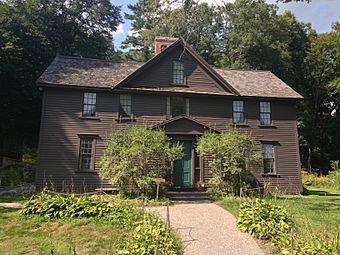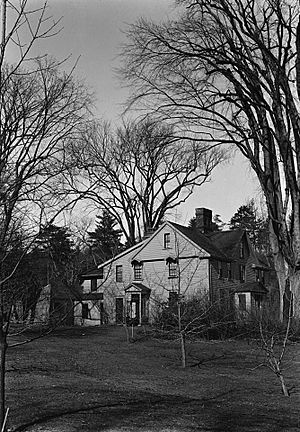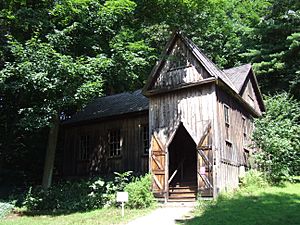Orchard House facts for kids
|
Orchard House
|
|

Orchard House, summer 2013
|
|
| Location | 399 Lexington Road, Concord, Massachusetts, U.S. |
|---|---|
| Built | c. 1700–1710 |
| NRHP reference No. | 66000781 |
Quick facts for kids Significant dates |
|
| Added to NRHP | October 15, 1966 |
| Designated NHL | December 29, 1962 |
Orchard House is a special historic house museum in Concord, Massachusetts, United States. It first opened to the public on May 27, 1912. This house was the home of Amos Bronson Alcott and his family for many years. His famous daughter, Louisa May Alcott, lived here and wrote her well-known novel Little Women (1868–69) in this very house. The story of Little Women is also set in and around Orchard House.
The four Alcott daughters—Anna, Louisa, Elizabeth, and Abigail—lived in Orchard House from 1858 to 1877.
Contents
History of Orchard House
The Alcotts Find Their Home
The house itself was built a long time ago, sometime between 1690 and 1720. The Alcott family first moved to Concord in 1840. They left for a while in 1843 to try living in a special farming community called Fruitlands.
The family returned to Concord in 1845 and bought a house called "Hillside." But they moved again in 1852, selling "Hillside" to Nathaniel Hawthorne, who renamed it The Wayside.
Making the House a Home
The Alcotts came back to Concord in 1857. They moved into Orchard House in the spring of 1858. At that time, it was a two-story farmhouse. The property also had two older houses and a 12-acre apple orchard. This is why the Alcotts named it "Orchard House."
When they first bought it, the house needed a lot of work. The Alcotts stayed nearby while repairs were made. Bronson Alcott, the father, made many changes to the building. He added special spaces for statues and fixed the staircase. He also put in bookshelves and built a studio for his youngest daughter May's artwork. He even moved a smaller house to connect it to the main house, making one larger building.
A writer named Lydia Maria Child visited the house later. She said it was "full of queer nooks and corners." She felt it looked like an old house from the Middle Ages. Orchard House is right next to The Wayside. It is also close to the home of Ralph Waldo Emerson, where Henry David Thoreau and the Alcotts often visited.
Life at Orchard House
Orchard House was the longest home for the Alcott family. They lived there from 1858 to 1877. The family included Bronson, his wife Abigail May, and their daughters Anna, Louisa, and May. Sadly, Elizabeth, who inspired the character Beth March in Little Women, had passed away just before they moved in.
The Alcott girls became friends with the Hawthorne children next door. The Alcotts were vegetarians and grew their own fruits and vegetables. They often talked about important ideas like ending slavery and getting voting rights for women. The family also put on plays in their dining room, with guests watching from the next room.
Family Life and Creativity
The parlor was a formal room. Bronson built special arched spaces there to show off statues of his favorite thinkers, Socrates and Plato. On May 23, 1860, Anna Alcott got married to John Bridge Pratt in this very room.
The youngest daughter, May, was a very talented artist. Her bedroom still has her sketches of angels and other figures on the walls and doors. In Louisa's room, May painted beautiful calla lilies and an owl on the fireplace. Copies of famous landscapes by J. M. W. Turner painted by May are in other rooms.
Where "Little Women" Was Born
In 1868, Louisa May Alcott wrote her famous book, Little Women, in her room. She used a special "shelf desk" that her father built for her. The story of Little Women is set inside Orchard House. The characters are based on her own family members.
Bronson Alcott also wrote several books while living in the house. These included Ralph Waldo Emerson (1865), Tablets (1868), Concord Days (1872), and Table Talk (1877).
A Place for Learning
Outside the house, Bronson Alcott built a structure first called "Hillside Chapel." Later, it became known as "The Concord School of Philosophy." This school was one of the first successful places for adults to continue learning in the country. It was open from 1879 to 1888.
In 1877, Louisa May Alcott bought a home on Main Street for her sister Anna. After their mother passed away that same year, Louisa and her father also moved into that home. The Alcott family officially left Orchard House by November 14, 1877. Orchard House was then sold to a family friend, William Torrey Harris, in 1884. Louisa said she was "glad to be done with it," even though it was "full of memories."
Visiting Orchard House Today
Orchard House is open for guided tours every day. It is closed on Easter, Thanksgiving, Christmas, and January 1 and 2. There is a fee to enter.
The outside of the house looks much like it did when the Alcotts lived there. Great care has been taken to keep the building strong without changing its old look. About 75% of the furniture and items inside belonged to the Alcott family. The rooms look very much as they did when the family lived there.
What You'll See Inside
The dining room has the family's china, pictures of family members, and paintings by May. The parlor has old-fashioned wallpaper and a patterned carpet. Family portraits and watercolors by May are on the walls. In the kitchen, you can see Abigail May's bread board, mortar and pestle, and wooden bowls. There's also a laundry drying rack designed by Bronson and a soapstone sink bought by Louisa.
Bronson's study has his library table, chair, and desk. The parents' bedroom has many of Abigail May's things, including photographs, furniture, and handmade quilts.
Learning and Events
Orchard House continues the tradition of Bronson Alcott's Concord School of Philosophy. Since 1977, they have hosted "The Summer Conversational Series." They also recently added a "Teacher Institute" for educators. The Hillside Chapel is used for programs for young people, poetry readings, and other special events.
See also



